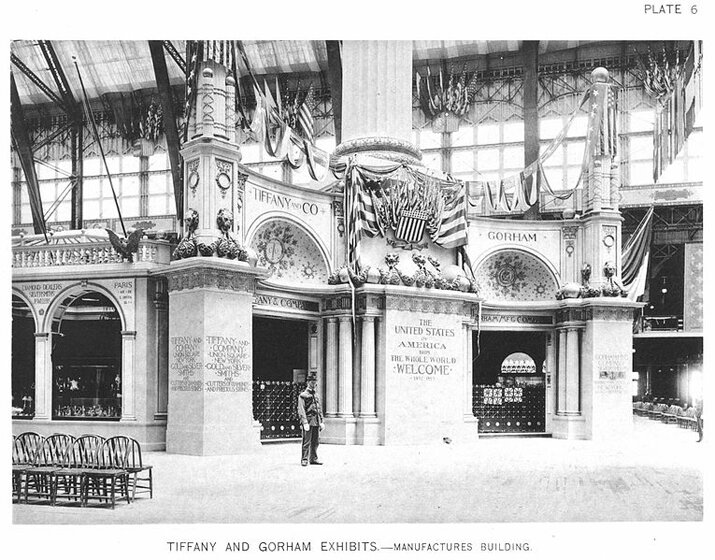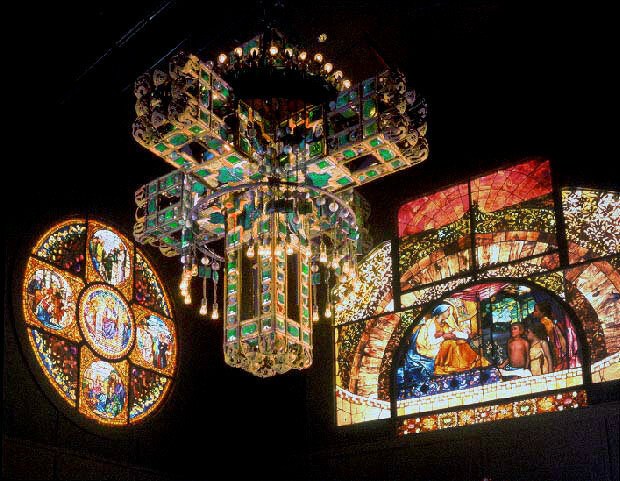From Orange Groves To A Tiffany Trove – Discovering The Charles Hosmer Morse Museum
This February, on a particularly cool and rainy weekend trip to Orlando, I was looking for something to do far from the theme park experience. I had the good fortune to find the Charles Hosmer Morse Museum of American Art in nearby Winter Park. Who knew that the world’s largest, most comprehensive collection of renowned American artist and designer Louis Comfort Tiffany’s (1848-1933) art glass, lighting and decorative art is located in central Florida?
The Morse’s expansive collection was started by Jeanette Genius McKean, a Winter Park resident and Tiffany enthusiast who had long appreciated Tiffany’s art during times when his reputation had faded amongst collectors and scholars. Founded in 1942, the Museum’s beautiful new building opened in 1999. One of the most stunning items I discovered in the Morse collection is the Tiffany Chapel. Intrigued by this beautiful, intimate, jewel-like interior that resides nearly intact at the Morse, I wanted to know more. Why was it created and where did it come from? A bit of research revealed that the fact the Chapel survives at all is a bit of a miracle.
Designed by Louis Comfort Tiffany and fabricated by the Tiffany Glass and Decorating Company of New York, the Chapel from conception was part spectacle and part publicity stunt. Intended to flaunt the craftsmanship of Tiffany’s atelier, it was first installed at the 1893 World’s Columbian Exposition in Chicago as the showpiece of Tiffany & Co.’s exhibit in the Manufacturers and Liberal Arts Building. Tiffany proclaimed it “a chapel in which to worship art”. Visited by more than 1.4 million people, the Chapel was greatly admired, won 54 awards and catapulted Tiffany to international acclaim. Men would doff their hats and visitors would sink to their knees in prayer, overcome by the radiance and beauty of the design.
Following the close of the fair, the Chapel was disassembled and put into storage. Chicago arts patron Celia Whipple Wallace purchased Tiffany’s interior three years later and had it installed in New York’s Cathedral of St. John the Divine, then under construction. However, when Ralph Adams Cram, America’s most prolific ecclesiastical architect and proponent of the Gothic Revival style took over design of the Cathedral in 1911, he so despised Tiffany and the decorative design of the Byzantine-Romanesque Chapel which he considered passé, he had the space boarded up and it was abandoned and fell into disrepair.
Tiffany himself rescued the Chapel in 1916, reinstalling it in its own building at Laurelton Hall, his 600-acre Long Island country estate. Following his death in 1933, the Louis Comfort Tiffany Foundation, facing financial difficulties due to the Great Depression, dismantled the Chapel and sold off many of its components. Then a devastating fire claimed the main house at Laurelton Hall in 1957. With the main house destroyed and facing imminent demolition and the Chapel building in poor condition, Tiffany’s daughter Louise Comfort Tiffany Gilder, contacted Jeannette McKean in desperation to see if remaining architectural elements could be salvaged for the Morse Museum. Mrs. McKean had numerous windows and other items, including the Chapel’s deteriorated interior, trucked to Florida. Over the next several years she and her husband tracked down nearly all of the elements of the Chapel that had been sold. In 1999, after two years of restoration, the interior was reinstalled in the Morse Museum’s new building.
The Chapel is an eclectic Byzantine-inspired Art Nouveau fantasy. Six massive carved plaster Romanesque arches, decorated with inscriptions in Latin, are each supported by double columns on an elevated stepped platform covered in thousands of colored mosaic tesserae. A marble and white glass mosaic altar shimmers like a floating cloud in front of the arches and incorporates gold glass medallions that represent the four apostles. Peacocks, symbols of eternal life, are splayed across the reredos under a crown composed of Tiffany’s famous Favrile glass. An orb-shaped baptismal font rests on a hexagonal columned base in the center of the Baptistry. Overhead, an immense emerald glass chandelier (which Tiffany called an “Electrolier”) in the shape of a cross is suspended from the Chapel ceiling.
Mystical and enchanting, the Chapel is installed with an automated lighting system cycles through various settings giving visitors changing visual impressions of the space. As the lighting reveals the details and creates glimmering effects on the iridescent tiles and glass, I found it is easy to imagine the awe that the Chapel originally inspired at the 1893 Chicago Exposition. Tiffany considered the Chapel his favorite among his thousands of works. Nearly everything he crafted later in his prolific career had its genesis in this stunning interior.
The Charles Hosmer Morse Museum is a welcome alternative to Mickey Mouse and his kin if you are visiting central Florida.




